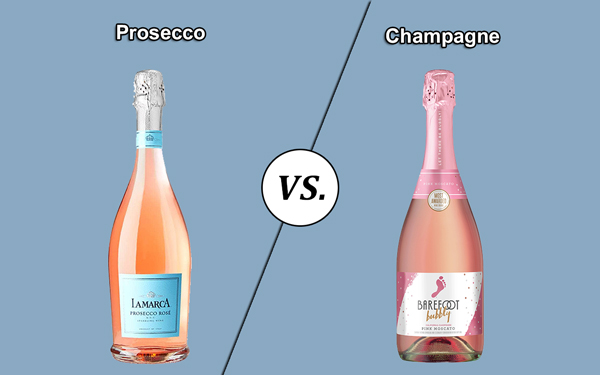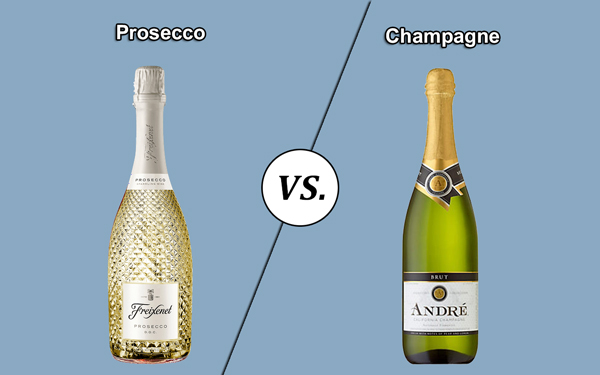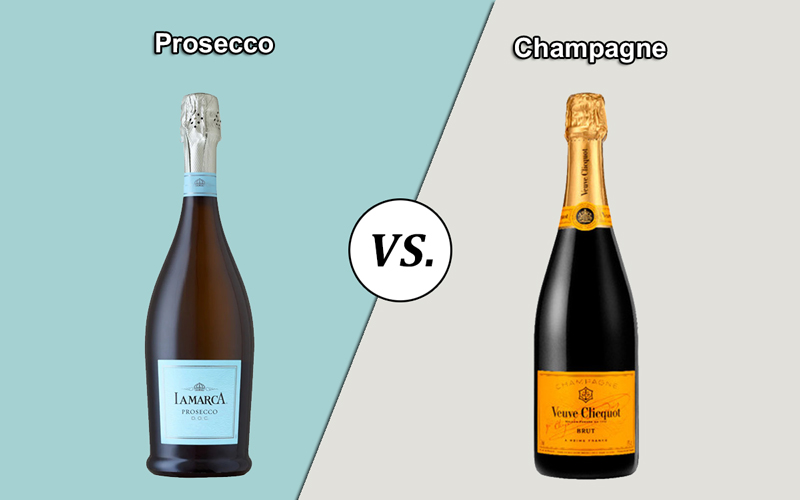Champagne and Prosecco are both types of wine, and their main difference is where they are made. Champagne refers to wines that are from Champagne, France. Meanwhile, Prosecco is a type of sparkling wine from Veneto, Italy.
Prosecco vs. Champagne: Quick Comparison Table
Here’s a quick comparison table highlighting the differences between Prosecco and Champagne:
Feature | Prosecco | Champagne | |||
|---|---|---|---|---|---|
Region | Primarily from Italy, Veneto | Primarily from the Champagne region of France | |||
Ingredients / Grape Varieties | Glera (mainly) | Chardonnay, Pinot Noir, Pinot Meunier (mainly) | |||
Production Method | Charmat method (tank fermentation) | Traditional method (secondary fermentation in the bottle) | |||
Taste Profile | Typically fruitier, floral, and lighter | Wide range from crisp and refreshing to complex and rich | |||
Sweetness Levels | Varied, from brut (dry) to extra dry (slightly sweet) | Varied, from brut nature (very dry) to doux (sweet) | |||
Bubbles | Usually larger and less persistent | Smaller, finer bubbles that last longer | |||
Price Range | Generally more affordable (Starts at $12) | Tends to be more expensive and premium (Starts at $40) | |||
Calories | 128 calories | 121 calories | |||
Sugar Content | approximately 1.5 grams | approximately 1.5 grams | |||
Alcohol Content | 12% | 12% |
Prosecco vs. Champagne: Understanding the Difference

Here’s a close look at the differences between prosecco and Champagne:
Prosecco vs. Champagne: Origin
Prosecco is made in the northeast of Italy, specifically in the Veneto region, which is also known as Conegliano Valdobbiadene. Its main ingredient is Glera grapes, a thin-skinned green grape that grows in the Veneto region.
On the other hand, Champagne is a name of wine exclusively for those made in the region of Champagne, France, which is located outside of Paris. The grapes used for Champagne can only be either Pinot Noir, Pinot Meunier, or Chardonnay grapes.
Prosecco vs. Champagne: Price
Prosecco is generally a more affordable option than Champagne because its manufacturing is less labor-intensive. The price of a 750 ml bottle of Prosecco starts at $12, while 750 ml bottles of Champagne starts at $40.
Prosecco vs. Champagne: Taste
Prosecco typically has a dominant fruity and flowery aroma, thanks to the grapes used in its production. It is also aged in a large tank with not much pressure, so its bubbles are lighter, frothy, and do not last as long as Champagne bubbles.
Champagne has more intense bubbles as a result of its carbonation. It also has almond-like flavors with hints of white cherry and orange zest. Some champagne has a cheese rind-like aroma since it’s aged with yeast particles.
Prosecco vs. Champagne: Calories
The calorie content of prosecco and Champagne only has a slight difference. A standard pour of Champagne has 128 calories, while a standard pour of prosecco has approximately 121 calories.
Prosecco vs. Champagne: Carbohydrates
Prosecco and Champagne have low carb content. A standard serving of these two usually only contains 1 gram of carb, making it keto-friendly.
Prosecco vs. Champagne: Sugar Content
Prosecco has a relatively low sugar content, especially those that are from the dryer variety. Meanwhile, Champagne has a slightly higher sugar content which is not surprising because it has a sweet taste. A 150 ml serving of Champagne and prosecco approximately has 1.5 grams of sugar.
Prosecco vs. Champagne: Alcohol Content
The alcohol content of prosecco and Champagne are not that high compared to other liquor. The ABV of a champagne and prosecco bottle is an average of 12%.
Prosecco vs. Champagne: Mimosa
Prosecco and Champagne can be used to make a mimosa. Prosecco mimosa typically has a more fruity taste, while champagne mimosa is fizzier.
Prosecco vs. Champagne: Brut
The term “Brut” refers to dry wine, which means it has little to no sugar left. Prosecco is produced brut style, but because of its grape’s fruity flavor, it is much sweeter. Meanwhile, Brut Champagne is excellent for food pairings.
Prosecco vs. Champagne: Cava
Cava is made with specific grape varieties such as Xarello, Parellada, and Macabeu, but it could also be made with Pinot and Chardonnay grapes. Its production process is similar to Champagne, so it resembles it a lot.
Prosecco vs. Champagne: Moscato
Muscato is often confused as a variety of Champagne and Prosecco, but it isn’t. Moscato is made with muscat grapes and has distinct orange blossom and peach flavors.
Prosecco vs. Champagne: Glass
Another key difference between Prosecco and Champagne is the glass used for serving.
A champagne glass is also known as a champagne flute. It has a tapered conical shape that holds around 190 to 300 ml. A prosecco glass has a similar shape to a champagne flute.
Prosecco vs. Champagne: Vinegar
Both prosecco and Champagne vinegar are bright and refreshing, making them ideal for salad dressings. However, Prosecco vinegar is a little darker than Champagne vinegar.
Prosecco vs. Champagne vs. Sparkling Wine: What’s the Difference?
Sparkling wine refers to wine that has fizz because it has significant levels of carbon dioxide. Prosecco and champagne are both types of sparkling wine. The only things that make them distinct from each other are the type of grape it’s made from and where it is made.
Prosecco or Champagne: Which is Better?

Champagne is better for people who prefer a sweeter tasting sparkling wine with a lot of fizz. On the other hand, prosecco is more suitable for those who prefer less fizz with stronger flavors of fruit.
Final Verdict
The key factor that distinguishes prosecco from champagne is where it’s made and the type of grape used in its manufacture. Champagne is considerably more expensive than Prosecco but that’s not a surprise because it’s a symbol of luxury and the manufacturing process is more complex. Nevertheless, Prosecco is still a good sparkling wine, especially if you are looking for value for money.

